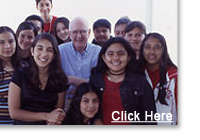Putting College Within Reach (From Colgate University)
February 24, 2013 in Articles by admin
From Colgate University’s Scene/Alumni Spotlights
Autumn 2012
By Aleta Mayne
 Although Lennox Middle School — located beneath the landing path of Los Angeles International Airport — is just a mile away from the Pacific Ocean, many of its students have never been to the beach. This hard-to-believe, yet telling, truth is what most struck Dr. Glenn Langer ’50 when he got to know the students of the school through a volunteer program established by UCLA. Having grown up during the Great Depression, Langer “immediately identified” with the poverty-stricken students, most of whom come from immigrant families. He decided to do something to help.
Although Lennox Middle School — located beneath the landing path of Los Angeles International Airport — is just a mile away from the Pacific Ocean, many of its students have never been to the beach. This hard-to-believe, yet telling, truth is what most struck Dr. Glenn Langer ’50 when he got to know the students of the school through a volunteer program established by UCLA. Having grown up during the Great Depression, Langer “immediately identified” with the poverty-stricken students, most of whom come from immigrant families. He decided to do something to help.
Langer was director of UCLA’s Cardiovascular Research Laboratory as well as a professor of medicine and physiology when he started volunteering at Lennox’s science fairs and career days back in 1995. “It was only 20 minutes from the UCLA campus, but it was another world,” he said of the school district, which is only 1.3 square miles but is troubled by 16 active gangs. “A lot of these children have never been out of that district in their lives. This gives you a rough idea of the disadvantage that they have.”
So, with his wife, Marianne, Langer founded The Partnership Scholars Program, an initiative that extends students’ learning and experiences outside of the classroom in order to pave the way for college. An inaugural War Memorial Scholar at Colgate and a scholarship recipient at Columbia Medical School, Langer knows the value of a helping hand.
After consulting Lennox’s principal and faculty, the Langers formulated three criteria for the program: a GPA of at least 3.0, the motivation for continuing education, and the support of a family member or guardian. They also decided to start the program with seventh-graders, “before they became gang associated,” explained Langer. Dipping into their retirement savings, the Langers launched the program with seven chosen scholars in 1996. Volunteer mentors — primarily Lennox teachers — were paired up with the students whose education they committed to fostering for the next six years. Mentors were given an annual stipend of $1,400 for “what a middle class family would provide for their college-bound child”: extra books, calculators/computers, SAT prep, summer-enrichment programs, college campus visits, museum trips, concerts, and plays.
Milagro Romero, now 26, is just one success story from that first class of scholars. Romero came from El Salvador with her parents at age 9, never having attended school and unable to read or write. With the program’s help, she graduated from Loyola Marymount University and earned a graduate degree from the University of Southern California. Today, Romero has come full circle: she is chair of the math department at Lennox and a mentor.
With the program now in its 16th year, 246 participants have graduated from high school, 93 percent of whom have been accepted to, are attending, or have graduated from a four-year university. The students have received more than $21 million in scholarships/financial aid — more than seven times the total investment by contributors to the program.
Fundraising and overseeing The Partnership Scholars Program has become a full-time job for Langer, who retired from UCLA in 1997. Under the administration of the nonprofit, the program has been expanded to nine school districts and 24 schools, where 265 scholars are currently preparing for college.
Competing for funds with 30,000 other nonprofits in Los Angeles County can be frustrating. “We just inducted our six hundredth child,” Langer said. “And that’s great, but there are eight times that who really need the program.” Currently limited to Los Angeles and Mendocino Counties, the program is replicable at any public school in the country, Langer said, with the caveat that the funds need to be raised and mentors found.
The Langers have personally invested about a million dollars in the program, he estimated. In 2010, at his 60th Reunion, Langer received Colgate’s Humanitarian Award.
The program’s impact is clear in the letters Langer receives from scholars like Maryell Hernandez, who wrote in 2007 on her way to Harvard with a $190,000 scholarship: “You give people hope that they can achieve more than what is expected of them — in most cases, nothing. You have not only given me hope, but also a sense of duty to do as much as I can to pay you back, not monetarily, but through my actions.” Keeping good on her promise, Hernandez is now in her second year with Teach for America. Langer said, “It doesn’t get much better than that.”
— Aleta Mayne

